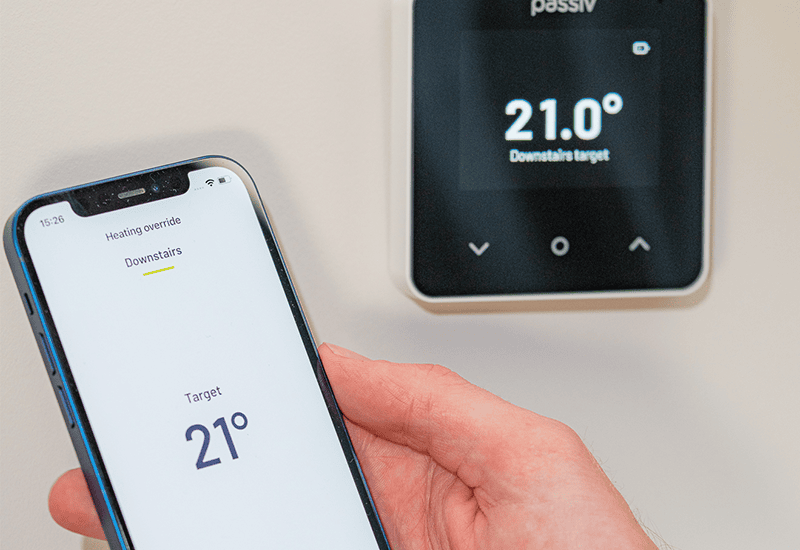This is the fourth Insight in our series exploring why heat pumps need smarter control. So far, we have considered the benefits smart controls can provide in improving efficiency, delivering better comfort and optimising to smart electricity tariffs. In this Insight, we examine the need for energy flexibility in the face of growing electricity demand and increased renewable generation, and how smart controls can provide that flexibility from heat pumps. You can read the previous entries in this series by heading to Insights.
You’ll often hear ‘flexibility’ thrown around as a buzzword in the energy industry. In simple terms, this just means shifting when you use electricity in response to an incentive or request. Demand flexibility is not a new concept. Network operators have been relying on it for decades to help balance electricity supply and demand and prevent blackouts. In UK homes, electricity tariffs such as Economy 7 have been around since the 1960s and are also forms of flexibility (if you want to find out how smart controls can help pumps take advantage of these tariffs, check out part three in the series). Together, these methods of shifting demand are known as Demand Side Response or DSR.
Historically, energy flexibility from homes has been small-scale compared to the energy shifting achieved in industry. This is going to have to change. The decarbonisation of both heat and transport will see a major uptake of electric vehicles and heat pumps. When combined with the increased usage of intermittent renewable generation, this poses a significant challenge to ensuring the UK has a reliable electricity supply to meet demand 24/7, 365 days a year.
Domestic flexibility became mainstream news in 2022 with the launch of National Grid’s Demand Flexibility Service (DFS). This scheme saw households across the country get paid to reduce their electricity consumption at certain times during the winter. The majority of these reductions relied on manual intervention – asking people to change when they cook dinner or clean their clothes in order to shift consumption away from peak times. This becomes a particular issue with high-power devices such as heat pumps. Manually adjusting consumption requires complicated scheduling and settings adjustment that acts as a significant barrier to participating in schemes such as the DFS.
Heat pumps pose a challenge to grid security. They are expected to increase the UK’s peak electricity demand from about 50GW to 130GW – an increase of over 150%. Heat pumps typically consume most power during cold winter evenings – times when demand is high and there’s no sun in the sky for solar panels to utilise. However, they also offer households a great opportunity to earn extra cash, with a unique potential for flexible operation. Heat itself is an energy source which can be effectively stored and, if carefully managed, this doesn’t need to result in a cold home.
All heating appliances provide warmth to a property and a certain amount of the heat provided is captured by the fabric of the building itself – that is to say, it doesn’t all immediately leave through the front door. The amount of heat stored in this way is dependent on a lot of different factors. The construction of the home, how well insulated windows and doors are and the external temperature all significantly affect a building’s heat loss. Homes are becoming better insulated as new regulations come into force and modern homes can maintain their temperature to within a couple degrees for several hours.
Trying to navigate all the different factors which can influence flexible operation of heat pumps is impossible to manage manually. Requests for DSR can come in all shapes and sizes and from all sorts of different parties. Whether it’s day-ahead, short-term, turn up or turn down, a householder cannot simply offer their heat pump to a network and expect the money to start rolling in. Combine this with the complexities of working out how and when to heat the home to maintain comfort whilst offering the greatest amount of flexibility and the challenges quickly pile up.
Smarter controls, like the Passiv Smart Thermostat, can uniquely access the opportunities offered by DSR.
The Passiv Smart Thermostat uses smart preheating to provide exactly the right amount of additional heat to a home before a DSR event. This allows the heat pump to use less power when required without letting the home get too cold. In addition, the Passiv Smart Thermostat considers a home’s hot water tank as a thermal battery. By heating up hot water before it’s needed, such as overnight when demand is low, the tank then keeps that water warm to be used later in the day when it is required. Households can shift their consumption, as they would with heating, whilst still having all the hot water they need. This provides an additional opportunity to provide even greater flexibility, which means even more earnings for the homeowner.
Smart, automated controls are already helping householders to earn money with their heat pump. In 2023, Passiv launched Greener Grid Payments, the UK’s first automated DSR service for heat pump owners. Passiv’s smart controls reduced heat pump demand at key times and paid owners directly for the reductions achieved. Surveying participants after the events, everyone agreed that this was achieved without impacting on their home comfort, that it was simple to take part in and they would definitely take part again.
The continued uptake of domestic flexibility provides an exciting new opportunity for heat pump owners. DSR will become essential for the stability of our energy system as it increasingly relies on renewable sources of electricity. A smart, two-way energy system allows customers to earn money through the devices they use. High-power devices such as heat pumps offer the most valuable source of flexibility, but to do so, they need to be operated in a smart, connected way. Controls such as the Passiv Smart Thermostat provide householders with a simple, automatic way of accessing the value their heat pump provides, maintaining their comfort throughout without having to lift a finger.
We’ve now covered the importance of domestic flexibility, the new opportunities that it presents for heat pump owners, and the role smart controls play in maximising its potential. But before the value of flexible heat pumps can be properly realised, we need to support more and more people in switching away from fossil fuels. In the transition to low-carbon heating, it’s essential that moving to a new heating system is easy for everyone. But how can smart controls help with that transition? Next time in our series on ‘why heat pumps need smarter controls’ we’ll be talking about the importance of simplicity and accessibility when it comes to heating controls.



